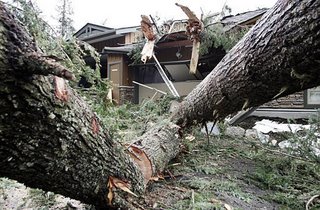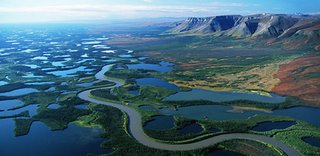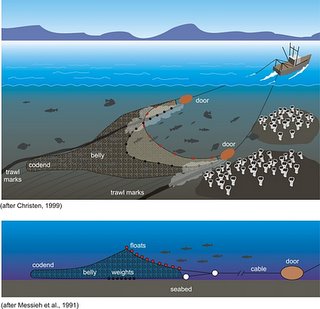Feeling wet? Get used to it.
The storms battering the B.C. coast this fall are a small taste of what our climate-altered future has in store for us. And although scientists have been steadily churning out increasingly troubling predictions about our changing climate, it seems that our development-minded politicians have had little time to read them.
This is leaving parts of the Lower Mainland woefully unprepared for the one-two punch of increasingly violent storms and rising sea levels.
A case in point: the city of Richmond and the tiny South Pacific island nation of Tuvalu both have an average elevation of only one perilous metre above sea level. Scientists are predicting eventual worldwide sea-level increases of more than seven metres. The government of Tuvalu is so alarmed by this that they have negotiated an arrangement with New Zealand to evacuate their entire population as their country disappears under the waves.

You certainly don’t hear about any plans to evacuate Richmond. In fact, nowhere in Richmond’s official community plan does the phrase "sea level" make an appearance.
The only reference to climate change is a commitment to “continue to monitor environmental trends and adjust city policies and programs as required”. This document was last amended in 1999.
However, there are signs that this elephant in the room is attracting some notice. A recent city-staff report to Richmond city council cited the need to amend Richmond’s flood-protection management strategy, which dates back to 1989.
The report appears to be the first effort to include climate change in city planning and assumes that sea levels will rise 35 centimetres by the next century. However, the authors also note that Canadian government researchers estimate that there is now a “high confidence” that the world’s oceans will rise by almost double that amount by 2100.
The challenge facing low-lying municipalities such as Richmond illustrates the implications of our changing climate and how many impacts will be felt very close to home.
In the past few years, climate scientists have drastically increased the predicted sea-level rises caused by climate change. Rising waters are due to both the thermal expansion of the world’s oceans as they warm and the release of massive amounts of water from melting ice sheets.
A recent NASA analysis of data from its GRACE satellite shows that Greenland’s ancient and massive frozen storehouse of water is pouring into the ocean faster than anyone anticipated, leading to predictions of an eventual long-term sea-level rise of almost seven metres from melting Greenland ice alone. Although it is highly unlikely that sea levels would rise that much in the near future, the long-term trend is very bad news for low-lying areas throughout the world, including Richmond.
So why haven’t these startling findings found their way into Richmond’s urban planning? One possible explanation is the blistering pace of growth in the city. Housing starts in the city increased by a record 40 percent between 2004 and 2005. The total value of building construction for permits issued in 2005 hit an unprecedented $499 million.
Richmond now has a population of more than 180,000, with a growth rate of four percent over the past two years. With that kind of increase, who wants to hear about a coming deluge?
If anyone is wondering, climate experts are clear on the local implications of rising sea levels. In a phone interview from Ottawa, James Bruce, a former Environment Canada scientist and expert on climate change, described Richmond as “a disaster waiting to happen…within 50 years, [rising sea levels in Richmond are] going to be a very significant problem.
“Our best estimates are that sea levels have been rising by about three centimetres in the last decade, and it seems to have accelerated in the last decade. That suggests that sea level might go up by somewhere between 20 and 40 centimetres by 2050.”
According to Bruce, even that projection may be overly optimistic. “Some people think that is a very conservative estimate and that the recent evidence of more rapid melting of the ice in Greenland, for example, suggests that we might well exceed those figures…”
It is important to remember that Richmond is not in the open ocean like Tuvalu and is not currently threatened by tropical cyclones. Low-lying areas such as Richmond are not one day simply under water due to rising oceans—the initial threat comes first from storm surges like the one that overtopped levees in New Orleans with tragic results. That makes increased storm activity and rising sea levels a deadly pairing, and something we should be keenly aware of here in B.C.

Last fall, about 200 waterfront homes in South Delta were damaged when a vicious storm breached the berm in front of the structures, causing more than $2 million in damage. The recent storms drenching the coast and flooding the Fraser Valley are a further sign of things to come.
A recent study out of the University of Washington shows that winter storms in the Pacific Northwest are predicted to dump 15 percent more precipitation on the B.C. coast by the end of the century.
“The atmosphere becomes more energetic because of climate change. It’s not just the temperature increase, but the increased temperature drives a more vigorous circulation,” Eric Salathé, a scientist with the Joint Institute for the Study of the Atmosphere and Oceans (which published the study last month in the journal Geophysical Research Letters), stated in a release.
That is bad news for B.C., Salathé noted ominously: “Alaska will really get it—Alaska and the British Columbia coast.”
Bruce agreed. “Winter storm activity has been increasing in the northern hemisphere for the last 30 to 40 years. That means that you could get quite significant storm surges on top of that rising sea. The evidence is very strong that wave heights have risen significantly in the Pacific and the Atlantic as the climate was warmed in the last 40 years.”
Given all that, Bruce feels, “You have a scenario that could easily give you problems in Richmond fairly frequently by 2050.”
Is there anything from an engineering point of view that will solve this problem in the long term? “No,” said Hadi Dowlatabadi, a Vancouver-based Canada Research Chair in global change at UBC and an expert on the impacts of climate change. “Not really. Not forever—unless we stop climate change in its tracks.” He believes that in the long term, overreliance on engineering solutions such as sea walls can make the daunting situation like the one facing Richmond even worse.
“The problem is that the more we rely on sea walls, the more we will be under the illusion that we are safe. The safer we feel, the more we will invest in capital behind a wall that eventually will collapse just like in New Orleans…The [U.S.] Army Corps of Engineers, by building the levees, set New Orleans up for exactly the disaster that happened. It’s sad, but it’s predictable.”

Dowlatabadi said that the most effective strategy in the short term is to ensure protection from big storms, something that is already partly there in the form of Vancouver Island. “I can imagine highly valued areas and highly influential property owners requesting construction of ever more prominent sea walls…But these will get overwhelmed by sea-level rise and storms eventually.”
The Dutch are world experts at reclaiming land from the sea by building dikes and then farming below sea level. But in recent years, they are rethinking this expensive practice. “The Netherlands is actually allowing many of their sea walls to collapse because they are finding their continued maintenance costing too much compared to the income these generate,” Dowlatabadi said. “Even though Amsterdam [Schiphol] Airport is six metres below sea level, the Dutch are careful not to develop towns in areas of high risk.”
He also pointed out that we currently lack insurance mechanisms that reflect the true costs of increasing flood and storm damage due to climate change. Earlier this year, this led a number of insurance companies in the U.S. to cease offering insurance in areas that are prone to such risks because of large storms and hurricanes, from the Florida Keys to New York state’s Long Island.
“Our research shows that development strategy on the coast has a huge effect on the eventual cost of sea-level rise to the community. If you have a community that allows repeated repair of shoreline properties after each damaging event, the total repairs will grow to be much larger in value than the cost of abandoning the land earlier on,” Dowlatabadi said. “It is like having a clunker that you keep repairing instead of buying a newer, more reliable car.”
He noted that rising sea levels also raise an important issue related to social justice. “The poor are in the same pool of risk as the rich who are living on the waterfront, and the premiums the poorer households pay reflect repairs to the damages of the rich…It’s ridiculous. We need bands of insurance risk that are much more specific than the [projected] 50-year and 100-year floodplains. In Florida, super-expensive shorefront homes are no longer included in the insurance pool underwritten by private companies. We need to signal the magnitude of risk to residents of each area through higher insurance premiums and perhaps higher taxes where the city has undertaken risk-reduction measures such as sea walls. However, this is where reliance on simple market forces may not be enough, and urban planners should step in—and with growth plans that reflect long-term risks of earthquakes and floods.”
This point is particularly poignant in Richmond, where homeowners are not even able to buy flood insurance. The recent report to Richmond city council calls for flood covenants and indemnity clauses for all discretionary development. This indicates that although development is not yet being discouraged, the city—like insurance companies—does not want to be held responsible if things get wet.
According to the staff report, Richmond currently has a perimeter dike system “designed to withstand a 1-in-200-year flood event [that] has been constructed around Lulu Island, protecting most of Richmond from all but extraordinary flooding”. This dike system is designed to be two feet higher than the highest water level ever recorded—in 1894.
The problem is that sea levels have already risen by 20 centimetres since then. Making matters worse, the entire Fraser River delta is sinking at a rate of one millimetre per year due to the accumulated weight of fresh sediments being dropped by the river. Given the situation facing areas such as Richmond, one would think it would be wise to direct population growth to areas less at risk from rising oceans. Is this happening?
“No, the opposite is happening,” said Tom Lancaster, Vancouver manager of advisory services for Smart Growth B.C. “We are seeing Richmond emerge as one of the new regional growth centres, which it wasn’t designated as in the [GVRD’s] Livable Region Strategic Plan [LRSP].”
The LRSP is supposed to direct where population growth takes place in the Lower Mainland, but proposed revisions have proven so contentious it hasn’t been updated since being written in 1996. One of the things the plan has not done is stop the expansion of Richmond as a growth centre.
According to Lancaster, “From the regional-planning perspective, the tail seems to be wagging the dog. The growth taking place in Richmond will probably force the GVRD to write Richmond into the next iteration of the LRSP as a regional growth centre.”
Richmond was never supposed to be a growth centre because of the enormous risk posed by areas with soils that will liquefy in the inevitable event of a large earthquake. Rising sea levels are just the latest reason to avoid densification there.
Lancaster also added that the $2-billion Canada line will not help. “A lot of that growth is being facilitated by the emergence of a new rapid-transit line connecting Vancouver with Richmond. In the context of risk-mitigation from rising sea levels, it’s one of the silliest things we could do.”
Why is regional planning not taking into account such an important issue? Lancaster offered these thoughts: “Planning in B.C. is limited by politics. Politicians don’t tend to want to work together for long-term goals. If they can be seen to be bringing in money to their municipality by doing development in places where development hasn’t happened before, they are dumping money into the coffers of their municipalities. Property developers don’t tend to look at long-term risks because once you develop a property and sell it, typically you walk away…From the paradigm of the development industry, there’s absolutely no point in looking at rising sea levels and the effect on properties that are being developed right now.”
Politicians have so far had the luxury of treating the enormous implications of climate change as mere hypotheticals that some future government would have to deal with. Much precious time has been wasted. Our changing climate is coming home to roost—whether we are ready or not. This will require fundamental changes in how we live and how we plan communities, not just in places like Tuvalu and Bangladesh but here in B.C.
The sooner we get on with that important work, the better.
Because it is going to get wet.
Mitchell Anderson is a freelance writer based in Vancouver. This was published in the Georgia Straight on November 23, 2006.
 Stephane Dion’s surprising smackdown of the Liberal backroom boys was not just highly amusing, it may also signal a much-needed infusion of new blood into Canada's "natural governing party".
Stephane Dion’s surprising smackdown of the Liberal backroom boys was not just highly amusing, it may also signal a much-needed infusion of new blood into Canada's "natural governing party". 


































